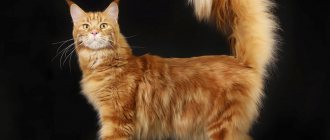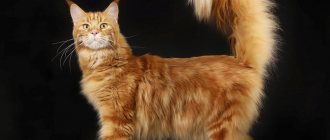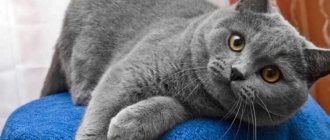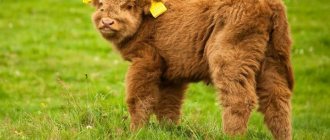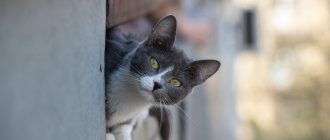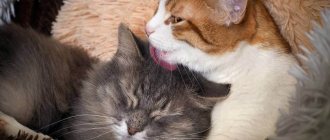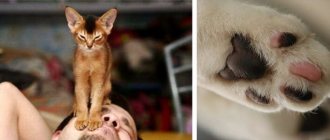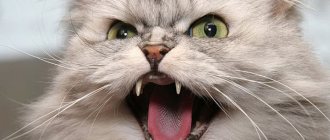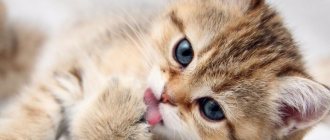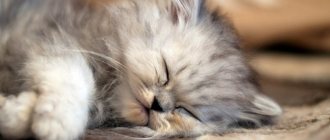, Persian lovers were attracted by their non-standard appearance with a characteristic flattened muzzle, and only then by their docile and affectionate character. Persian cats are the embodiment of royalty and at the same time tender love and devotion. These cats are simply ideal for families with children, as they love to be the center of attention and will never harm their owners or their loved ones.
The Persian cat is a rather massive, but well-balanced animal, with a soft expression on its face. Long, thick hair gives the body lines roundness and smoothness. The animal's head is massive, round, the skull is quite wide. The nose is short and snub, the nose should be colored in accordance with the base color of the cat. The cheeks are full, the chin is well developed, it is rounded and even a little full, the cat's jaws are wide, with the correct bite. The tips of the ears are rounded, the ears are set wide and do not distort the round shape of the skull.
photo: Persian cat
The eyes of representatives of this breed are very lively, round, slightly protruding. The neck is short, goes into a squat body on short legs, the shoulder region is massive, the chest is deep. The cat should not show signs of obesity, all muscles should be toned. An entire adult Persian can reach 7 kg.
The animal's legs are strong and thick, although somewhat short. The paws are strong and round, there should be no dewclaws. The tail is proportional, short and level. The coat lags behind the body, the hair is long, thick, shiny, and the texture is soft. A well-furred tail and a luxurious frilled collar are very important. There are many variations of Persian colors: even color (white, black, red), chinchilla, lilac, chocolate, smoky, tortoiseshell and others.
Disadvantages include deformations of the skull and body, short stature or high weight, anatomical defects, irregularly shaped eyes and yellow eyes, pigmentation of the eyelids, a tail that is too long or curved, high legs, non-standard color of the pads, and the condition of the coat.
photo: Persian cat has slightly bulging eyes
Persian longhair breed
| Breed name | Persian longhair cat (Persian) |
| Path of occurrence | Aboriginal breed with further development |
| Country of origin | Armenia, Iran, Türkiye |
| Coat | Longhair |
| Lifespan | 15 – 20 years |
| Cost of a kitten | 5 – 15 thousand rubles. |
Characteristics and habits of Persian cats
The Persian cat is not only immensely charming, but also very obedient, so from a young age he will simply fit perfectly into any home environment. The docile nature of this animal allows it to easily understand and accept the rules of behavior dictated by the owner of the home.
Raising a kitten takes place without unpleasant surprises, since close contact quickly arises between it and its loving owner. As the Persian pet grows up, it lends itself well to simple training, which can bring it even closer to humans. And numerous reviews from the owners of these luxurious animals testify to the extraordinary intelligence and intelligence of the Persians, as well as their affectionate nature. That is why these fluffies take any disapproval or rudeness from the owner very close to the vulnerable cat’s heart.
The whole family can be endlessly touched by the habits of Persians, especially since the baby is ready to make friends with both its younger members and other pets - from hamsters to parrots. Children also love to tinker with shaggy cats, however, the latter should still be explained that they should not bother the cat too much with affection if he is not very inclined towards them at some point.
History of the origin of the Persian breed
Special cats with thick fur appeared in Persia, which is why their name appeared when Pietro della Valle, a traveler from Italy, came to the Middle East in the 17th century. It is he who should be thanked for the appearance of the Persians - he brought animals with large ears and a straight long nose to Italy.
Other mentions were made a hundred years later, when the French biologist Georges-Louis Leclerc described them in his writings. The engravings found show the similarity of Persian cats with Turkish Angoras - the ears are widely spaced, the nose is short, snub-nosed, and the skull is wide. In addition, some scientists assumed that cats could have appeared in Rus' and called them Russians, since it was in harsh cold conditions that they could acquire their thick fur.
Breeders became interested in Persian cats already in the 19th century, when in Great Britain they set out to change the appearance of cats. At an exhibition in 1887, Persian cats as we used to know them were recognized for the first time as a separate breed.
Persians began to gain their popularity at the end of the 19th century, when they were brought to the United States. Over time, after American modernization, a new type appeared - extreme Persians - the nose shortened and is approximately at eye level.
I consider Persian cats to be truly royal - their beautiful, flowing fur, sweet face and calm character have made this breed the most in demand.
Persians are part of the world's largest cat pattern
Sold for a whopping $826,000, the world's largest cat painting, titled My Wife's Lovers, depicts Turkish Angora and Persian cats.
The huge composition entitled "My Wife's Lovers" was painted by the Austrian artist Karl Kahler around 1893. is a large piece of art measuring 6 by 8.5 feet, earning the title of the world's largest painting of kittens.
There are a number of other famous paintings of Persian cats, but none of them are as great.
Description of the breed
Persian standard
There are currently 4 main types of Persian cats recognized:
- The classic type (British) is outdated, with a noticeable nose, the edge of which is located 5-6 mm below the edge of the inner corner of the eye.
- Modern type (short nose) - have an open look, the bridge of the nose is raised. Thanks to the wide eyes, the nasolacrimal ducts are not deformed, and the animal does not have a gloomy expression on its face.
- Extreme type (American) - the breed description is characterized by a short nose, round forehead, low-set ears, and straight-set eyes. The earlobe is almost at the same level with the inner corner of the eyes.
- Pig type (piggy) - the convexity of the skull is almost not pronounced, low weight, weak bones. This type is derived from the extreme.
classical
modern
extreme
pig type
Regardless of the type, the following standard characteristics are distinguished:
- Body: massive but compact; the chest and stomach are wide, rounded; the tail is proportionally short, very fluffy; average weight for females is 3-4 kg, for males 5-6 kg.
- Coat: silky, soft long hair covering the entire body; There are more than 200 species of Persian cat colors, including the graceful white Persian chinchilla.
- Head: muzzle flattened, almost flat, bone wide; forehead is rounded; the nose is short and raised.
- Eyes: wide-set, large and expressive; eye color can be green, blue, brown, and can also differ from one another (colorpoints with blue eyes and chinchillas with green should be noted separately); friendly look.
- Ears: usually small, low set, rounded tips; hidden behind abundant fur.
- Limbs: paws are fluffy, thick, proportionally short relative to the body.
- Life expectancy: extreme Persians live up to 15 years, ordinary modern Persians under normal conditions can live on average up to 20 years.
Colors
- Solid (solid) - solid colors: white, black, blue, red (red), lilac, cream, chocolate. There are no patterns or streaks on the wool. Eye color is most often copper and dark orange or dark blue in white Persians.
- Bicolor is a combination of a primary color and white. The color of Persians is rare for Russian exhibitions, since breeding such a capricious spotted color requires a lot of effort. Bicolors should have at least 1/2 and no more than 2/3 white in color, with white spots on the head and tail desirable.
- Tabby - patterns on the fur: stripes, spots and marbles. Any basic coat color.
- Color point is the so-called Siamese coat color with dark spots on the face, paws and tail. Popular colors include brown, lilac, blue and black spots. Persian color-pointed cats were even identified as a separate breed - the Himalayan cat.
- Smoky is an amazing color in which each hair is conventionally divided into 2 color parts: a light base at the root and a dark color at the tip - tipping. At rest, the cat appears monochromatic, but when moving, the light undercoat becomes visible. Shades: black smoky, blue smoke, chocolate, tortoiseshell, lilac.
- Chinchilla - Golden and silver Persian chinchillas are now considered very popular and popular colors of the breed. Black tipping (the hair is colored only 1/8 with a dark tip) is evenly distributed on the back, sides, head and tail. The main color of gold is light apricot, while that of silver is pure white. A characteristic feature of chinchillas is the black rim around the eyes, nose and lips.
- Tortoiseshell is the color of Persian cats, in which there is a combination of two primary colors at once - red and black or their lightened analogues - cream and blue. This also includes the calico - a combination of tortoiseshell and white.
Does wool get in the way? It needs to be shortened!
This is exactly what breeders probably thought when they started breeding short-haired Persians. Indeed, long hair requires careful care and causes inconvenience to furry owners. Therefore, a variety of the breed was developed - exotic shorthair (abbreviated as exotic). Cats have inherited genetic diseases of Persians, their head and nose structure, but the fur of these animals is much shorter.
Exotic shorthair cat
Gallery of photos of Persian cats
Solid colors
red
black
white
blue
lilac
chocolate
Bicolor - two-color
red bicolor
black bicolor
Blue bicolor
Lilac bicolor
Tabby
red tabby
black marble
brown tabby
golden tabby
red marble
Color point and smoky
black smoke
blue smoke
chocolate smoke
color point
color point
Chinchillas and turtles
golden chinchilla
silver chinchilla
tortoiseshell
calico
Tortoiseshell color
This type of coloring is characteristic only of females. Males very rarely have this color, and, as a rule, are not capable of reproduction. The fur of such cats is colored black and red, or their lightened varieties. The spots are evenly distributed throughout the body. The offspring of turtles have different colors.
A simple turtle is colored black and red, while red can have different shades. As a rule, shorter hairs are colored in light colors, and longer hairs are colored in dark colors.
Other types of tortoiseshell colors include blue-cream, chocolate-cream and lilac-cream.
Health
The lifespan of Persian cats is one of the longest - with a loving owner and favorable living conditions, a cat can live more than 20 years.
Unfortunately, these cats are predisposed to hereditary diseases. Among the most popular and frequently encountered are:
- Bladder stones.
- Polycystic kidney disease.
- Cystitis.
- Congenital liver problems.
- Progressive retinal atrophy.
If any symptoms occur, treatment and even surgery are necessary. That is why potential buyers are advised to be very careful when choosing a breeder to purchase a kitten; they need to carefully check the pedigree and make sure that there have been no previous cases of the disease.
Pros and cons of the Persian breed:
Key facts
Due to several theories about the origin of the breed, the country of origin of Persian cats is still in question. Most felinologists lean towards Persia (Greater Iran). Unlike modern Iran, the ancient state occupied a large territory.
The maximum lifespan of a Persian cat is 20 years. The smallest females weigh only 3.5 kg, and the largest males can reach 7 kg. Height at the withers does not depend on gender and is no more than 30 cm. The description of the Persian cat breed emphasizes that the animals are not too large, but quite massive.
Due to its characteristics, the Persian cat is included in the ranking of the most beautiful cats. In the 7th-8th centuries, only European aristocrats could boast of a luxurious pet. Among the breed's admirers was the Red Cardinal himself, the Duke de Richelieu. Before his death, the man bequeathed his entire fortune to cats. Unfortunately, the rich heiresses were unlucky and all the money was divided among the servants.
In the 20th century the situation changed. The transfer of the inheritance of the Queen vocalist, who bequeathed all his property to his cats, was successful. Freddie Mercury took care of the legal aspects in advance and delegated the management of cases to experienced lawyers.
Persian cats are not able to live on their own. They do not know how to hunt and are not adapted to life in the wild. A comfortable life for this breed is only possible next to a person.
Persians are very attached to their owners, but try not to bother them. They won't become your shadow, but they will definitely nestle at your feet or headboard as night approaches. For such animals, human presence is a prerequisite. If you rarely appear at home, then look for a more suitable breed.
Character of the Persians
The obedient Persian is known for being quiet and sweet most of the time. They are affectionate and picky, they give all their attention to their owner, but at the same time they are wary of house guests.
Important! Persian cats make excellent companions for their owner's family - they are calm and do not fuss unreasonably.
The Persian cat's personality is very calm; loud environments are frowned upon. Their usual needs and activities include eating, playing with toys, and napping during the day. And the most important thing for them is a lot of love, which a caring owner will be able to give to her by carefully combing her fur.
Such cats are unlikely to jump on your curtains or chew your wallpaper. While the family is not at home, the quiet cat prefers to be the decoration of the chair, waiting for his evening portion of care.
Persians act in films
The Persians have their place in history and on the silver screen. In addition to the well-known Fancy Feast mascot, James Bond's nemesis Blofield had a grizzled, blue-eyed Persian companion.
And, let's not forget, Mr. Bigglesworth, of Austin Powers fame. (In a slight plot twist, the Persian version of Mr. Bigglesworth was replaced by a hairless sphinx cat for the rest of the film.)
Differences in appearance and character: Persian, British Longhair and exotic
| Persian cat | British longhair cat | Exotic shorthair cat | |
| Peculiarities |
|
|
|
| Character |
| isolated and independent, calm temperament | calm, affectionate and friendly character |
| Difficulties |
|
| Grooming does not require much effort and time; dense wool does not need to be combed frequently |
| Dimensions | Average weight 3-5 kg, male 4-6 kg | Average weight 4-7 kg | The average weight of females is 5 kg, males up to 7 kg |
| Nutrition | Many prohibited foods due to digestive characteristics | The amount of food should be strictly measured, prone to overeating | They are demanding on the diet, most often they use specialized industrial feed of super-premium class and higher |
Catering
Both experienced breeders and doctors say one thing: Persians should be fed in accordance with their health and age. From an early age, teach your cat to eat at a certain time.
Natural products
- Kittens feed on demand for up to a month;
- 1-2 months – eat 6 times a day;
- 2-4 months – 4-5 times a day;
- 4-6 months – 3 times;
- From 6 months – 2 times a day.
Daily food intake: 250 g per kilogram of live weight. For an adult cat – 300-350 g.
The first complementary food for a Persian baby is porridge cooked in diluted milk. From 3 months you can give frozen meat (naturally, before eating it is defrosted, doused with boiling water and minced). Serving – 0.4 teaspoon.
From 5 months, fermented milk products (natural yogurt, cottage cheese, low-fat sour cream, kefir, fermented baked milk), quail eggs, chicken yolk, and vegetables are introduced. You can also give children's cereal-vegetable mixtures.
Dry and wet food is allowed from 6 months. At first, the pads can be soaked in broth.
The diet of an adult cat should include:
- Meat (veal, rabbit, lamb, chicken, beef) – 50-60% of the total diet;
- By-products (chicken hearts and kidneys, raw cow stomach);
- Sea fish (salmon, hake, trout, cod) - no more than once a week;
- Vegetables (carrots, beets, green beans, pumpkin, cauliflower, zucchini) – every other day;
- Cheese (unsalted): once a week;
- Porridge (oatmeal, rice, buckwheat, millet, barley, for kittens up to 3 months - liquid semolina) - daily;
- Clean warm water: freely available (it is changed in the mornings and evenings).
Do not give to Persians:
- Milk
- Fatty meat (pork, goose),
- Smoked, salty, sweet, canned,
- Sauces, seasonings, spices,
- Baking,
- Bones and tripe
- Alcohol, carbonated and mineral water,
- Eggplants, potatoes, garlic, onions,
- Fat cottage cheese.
Recommended food
The best industrial food for Persians:
- German food based on poultry meat, vegetables and rice Sanabelle.
- Italian Purina Pro Plan Delicate: food for sensitive digestion (40% protein, there is also a vitamin complex).
- Royal Canin Persian (Royal Canin, France): contains chicken, cereals and vegetables.
- Orijen Cat 6 Fresh Fish comes in the form of granules with a fishy smell that is pleasant to the cat. Contains a vitamin complex.
Expert opinion
Dusheba Vera Ivanovna
In 2010, she graduated from the Moscow State Academy of Veterinary Medicine named after K.I. Scriabin with honors, specializing in veterinary medicine. I regularly attend veterinary conferences, congresses, and webinars.
Industrial feeds are divided into 4 groups: economy, premium, premium and holistic. You should buy economy class food only as a last resort: they are poor in nutrients and protein, contain harmful dyes and additives, and can ruin your pet’s stomach in a short time. Premium food is somewhat richer in composition, but the amount of meat in them is minimal, there are preservatives that are harmful to health, and often cause allergies. Premium class and holistic are the most suitable options: they contain the required amount of protein and fiber, and add all the necessary vitamins and minerals.
Below are recommended super premium foods, links with food names are clickable. Using them, you can, within our website, read descriptions of food and read reviews from owners of the Persian cat breed.
| Premium | Premium | Holistic |
| Pro Plan | Royal Canin Persian | Golden Eagle |
Possible problems
The Persian breed is considered quite whimsical, so it is not recommended to have such a cat for constantly busy people: after all, additional time is required to care for the coat
It is not recommended to have a cat of this breed if there are many children in your house, but they will be very happy with the tender and affectionate attention of children.
Important! Persian cats contain a lot of allergenic protein and spread it very actively, which is why they are considered one of the most dangerous breeds for allergy sufferers. Increased shedding, watery eyes and nasal discharge are dangerous.
Persians are very domesticated and affectionate animals, so it is quite difficult for them to get along with other cats or dogs. Also, it is not recommended to let them go outside, as their fur is very difficult to clean from debris or leaves.
Persians have incredibly thick fur
Another distinctive feature of the Persians is their long, luxurious hair. Consisting of two layers of coat - a shorter undercoat and a long, silky topcoat - Persian coats tend to shed heavily.
If you're thinking about getting a Persian, or you already have a Persian and are buried in cat hair, here's our advice: Get a vacuum cleaner specifically designed to suck up cat hair, place a few strategically hidden lint rollers around your home, and stop wearing black.
Care
The Persian cat can rightfully be called one of the most demanding of attention and care. What requires most attention is a chic fur coat and a balanced diet.
Wool
The most important thing in caring for a Persian cat is to understand that he will need daily care. This long, beautiful coat by itself cannot remain clean and tangled: tangles of the undercoat can form very quickly, which causes great inconvenience to the animal, and it is very difficult to comb them out.
The pet must be gently but thoroughly combed every day, first soothing it with smooth strokes, and then carefully combing it with a special long-toothed brush according to the hair growth. At the end of the procedure, you need to use a spray with an antistatic effect.
Advice! A good purchase would be a furminator - a special comb-trimmer with frequent metal teeth, which will ease the spring-autumn periods of shedding in Persians.
Bathing is not the most favorite procedure for cats, so the optimal frequency is once a month. After washing to dry, it is better to use a hairdryer on low power to avoid drafts and the likelihood of a runny nose and colds.
How to cut a Persian's hair is a very popular request; however, cats do not require a specialized haircut, but sometimes matted fur needs to be cut off. Grooming Persians can be a solution for owners and pets who live in hot and humid climates. For the summer period, the hair from the body is cut off, without affecting the head, tip of the tail and toes.
It is important to keep the litter box clean as droppings and litter pellets can get stuck in paws or on thick fur. If you don't clean it out scrupulously, the Persian may become stubborn and start shitting in the wrong place. Some Persian owners prefer to slightly shorten the hair between the toes, which reduces the problem.
Nutrition of Persian cats
Persians often have problems with the digestive tract, so their nutrition must be approached with particular seriousness.
The basis of their natural diet should consist of lean meat, which is given boiled, baked in the oven or even raw. Several times a week you can add organ meats or fish. In addition, cats also receive vegetables, most often boiled carrots, cauliflower or broccoli, zucchini and pumpkin. Be sure to add low-fat fermented milk products (yogurt, kefir, cottage cheese) to your animal’s diet.
If you decide to feed your cat natural food, then you need to additionally add age-appropriate vitamins and taurine to the diet.
Important! As an alternative, you can use ready-made food, but it is not recommended to choose manufacturers from the economy segment. What you feed your cat determines its lifespan.
Many experts believe that cats after castration are less active, eat more and begin to gain weight, but this is not entirely true. If you correctly calculate the daily ration and prepare a diet with a limited fat content, and also keep your cat busy with active games, then weight gain will not occur.
Advice! Buy stable, wide, but not very deep bowls for water and food so that your Persian is less likely to stain the hair on his face while eating.
Dry food for Persians
The Persian breed is so popular and numerous that special food is produced for Persians to maintain the beauty of the coat and its easy removal from the intestines. Popular brands:
- Royal Canin Adult Persian is a specialized food for Persians from Royal Canin.
- Pro Plan Optiderma Elegant – for healthy skin and coat.
- Grandorf Cat Indoor will not only help maintain the beauty of the coat, but will also reduce allergic reactions in cats with sensitive digestion.
- Orijen Cat 6 Fresh Fish - small granules of food are perfect for Persians with extreme stops, so cats will not need to open their mouths too much when eating. Origin belongs to the holistic class.
Caring for ears, eyes and claws
The ears should be cleaned with a cotton swab soaked in a special lotion once a week.
Since the eyes of Persian cats have specific tear ducts, they regularly secrete secretions, which is why the eyes often water. It is difficult to remove discharge without causing inconvenience to the cat, so dried crusts should be wiped with a cloth and eye care product.
Regular nail trimming is necessary for the animal; you can do this yourself using a nail clipper: you need to carefully cut off only the tip of the claw to avoid injury to the vessel inside.
Walking your pet
Persian cats are rarely taken for walks: they are calm in nature and do not want to go on a trip. It is enough for them to be in the space of the apartment, and they can watch everything that happens from an open window.
If the owner has a private house and prefers to let the cat outside, then experts recommend fencing off a section of the garden for him where he could spend time, but even in such conditions he must be constantly monitored. And don’t forget to treat your cats for ticks and worms, and for the summer, you can purchase a collar impregnated with an anti-parasite agent.
Cat colors: genetics of their breeding
The color of a cat is a complex concept and includes not only the color of the animal’s fur, but also the pattern on it (spots, stripes, etc.), as well as the color of the skin (nose, pads on the paws) . Pigmentation is determined by the presence of different amounts of coloring particles (melanins). There are only two pigments:
- elongated elongated granules responsible for pure black color and absorbing almost the entire visible spectrum - eumelanin;
- almost round spherical or slightly oval particles operating in the red-yellow range - phaeomelanin.
The intensity of colors varies, this is determined by the presence of a special diluent gene (D):
- diluted black - blue (gray), chocolate, cinnamon, brown, fawn, lilac;
- diluted red - cream.
The genes responsible for the manifestation of red (O) and black (o - not red) are sex-dependent and located on the X chromosome. Females have the XX chromosome set, so the following combinations are possible, giving three color options:
- OO - red (orange);
- oo - not red (black);
- oO and Oo - tortoiseshell.
Males have an XY set of chromosomes, so they can only have O (red) or O (black). A cat cannot have any combination of black and red colors.
There are only two primary colors involved in the coloration of cats: black and red.
Almost only cats are tricolored, not female cats, since only the X chromosome determines the color of the coat and only females have two X chromosomes. Typically, cats have one X chromosome and one Y chromosome, so it is almost impossible for a cat to have two pigments at the same time: orange pheomelanin and black eumelanin. There is one exception: when, in very rare cases, cats have the XXY set of sex chromosomes, they can be tortoiseshell (two-colored) or tri-colored. Most of these cats are sterile due to an abnormality associated with the presence of two X chromosomes
Video: genetics of tortoiseshell color
How to choose a Persian kitten
First of all, you should pay attention to the purpose of the choice - if you want to participate in exhibitions, then the mother cat must be selected from a special club with a mandatory ideal pedigree and the cost will be correspondingly high. If the kitten is for home and for your soul, then you need to find out from the breeder about the type of breed, the health of the offspring, and the presence of diseases in its parents.
Advice! The breed type appears in the baby at about 2-4 months, this is the optimal time for choosing.
It is advisable to take the kitten out of its familiar environment so that you can assess its contact with other animals, find out whether it feeds itself and whether it is potty trained. A healthy kitten should show interest in everything around it, including you. He should be clean and his coat should be smooth.
The price of kittens varies depending on the type of cat and color; eye color is also important. The most expensive colors will be golden and silver chinchillas, solid (snow white, black), smoke and tortoiseshell calicos. On average, breeders offer to buy a two-month-old kitten for 5 – 15 thousand rubles.
blue kitten persian
gray bicolor
Solid color
With this color, the cat’s coat color has one shade, without any markings. In addition to the three basic colors, cats of this type can have blue and cream colors, which are the result of lightening black and red, respectively, as well as lilac and chocolate.
Black kittens under 8 months of age may have uneven coloring. Their fur contains white hairs and gray spots, sometimes rust-colored hairs.
White kittens may have spots of different shades on their heads, but they disappear over time. Cats often have eyes of different shades. Also, some are born deaf, which is due to the gene that carries the color white. However, according to the results of breeding research, it was possible to achieve a high percentage of hearing cats.
Breeding
Breeding purebred Persians is a big responsibility; it will take a lot of effort and money to start your own business. The choice of an ideal mating partner must be very serious, since only breeding cats are chosen for owners of high-breed cats.
But choosing the best individuals does not always lead to ideal offspring: kittens are often born with various defects in their appearance. Therefore, many breeders prefer a compensatory breeding method, in which both individuals have some defects in appearance, but are necessarily different.
If the owner has seriously decided to engage in crossing high-breed cats, then one should very carefully study all the possibilities of crossing non-ideal partners in order to establish the possibility of anomalies in the exterior and their transmission to offspring.
| Nursery name | City | Official website of the nursery |
| BAR'LAND RUS | Moscow | https://barlandrus.ru/ |
| LumiCat | Moscow | https://www.lumicat.ru/ |
| FLUFFY FLOCK | Moscow | https://fluffycat.ru/ |
| SNOW DREAM | Moscow | https://snow-dreams.ru/ |
| HELGA'S CAT | Saint Petersburg | https://helgas.name/ |
| MATIOLLA | Samara | https://matiolla.com/ |
Child of star, fire and smoke
The history of the emergence of Persian cats, framed by mysterious myths, has its roots in the distant past. For example, one of the most famous and poetic legends says that once a magician was attacked by robbers, but, fortunately, the hero Rustam was nearby, who freed him. The grateful wizard asked his savior what to give him as a gift. However, the modest Rustam replied that all he needed was the starry sky above his head and a fire emitting a pleasant aroma of smoke.
Then the magician called to himself a small spark of fire, added a gray curl of smoke to it and removed the two most distant and brightest stars from the sky in order to obtain from these magical ingredients a small Persian kitten, which he gave to the brave Rustam as a companion. This legend explains how the Persian cat became the owner of long hair that flows like smoke, sparkling intelligence and starry eyes.
pixabay.com/maxmann
Features of caring for a Persian cat
The main difficulty that the owner of a Persian cat faces in the process of caring for him is, of course, tidying up the animal’s fur. It is extremely long, and therefore requires daily attention in the form of combing. Otherwise, tangles will very soon form on your Persian’s fur coat and there will be no opportunity to sort out the tightly woven fine hairs.
To make combing easier, some breeders recommend adding a little talc to the coat. Fortunately, the Persian cat treats grooming with understanding and quickly gets used to it, since they begin to care for it already from the tender age of a kitten. But this fluffy doesn’t really like to wash, but for the sake of the external beauty and health of the coat and skin, you still have to do it - with the help of special shampoos. And one more important point: since a clean animal, despite careful care from the owner, still often licks its fur coat, it is advisable to give the pet a special paste so that the numerous fur that gets into the stomach does not cause harm to your pet.
A Persian cat's claws can be trimmed once every couple of weeks. We assure you: due to the calm nature of the pet, this procedure in most cases will not cause problems for the owner.
pixabay.com / @lindarczyk
